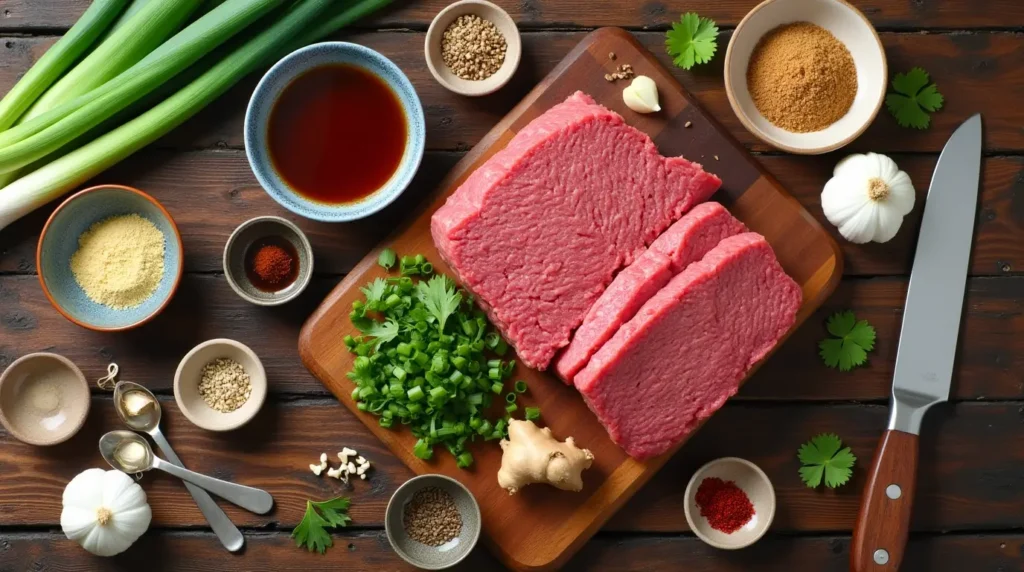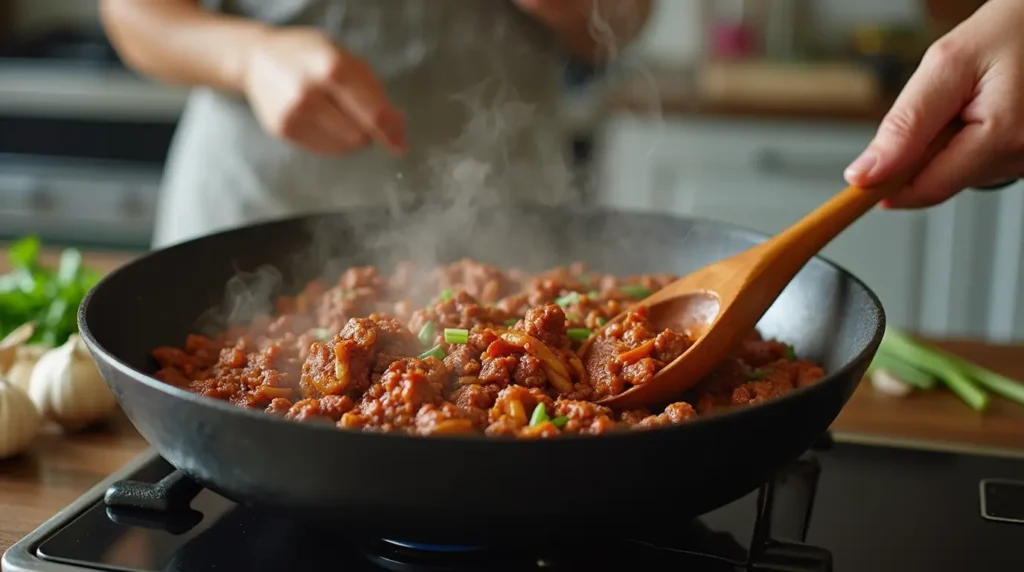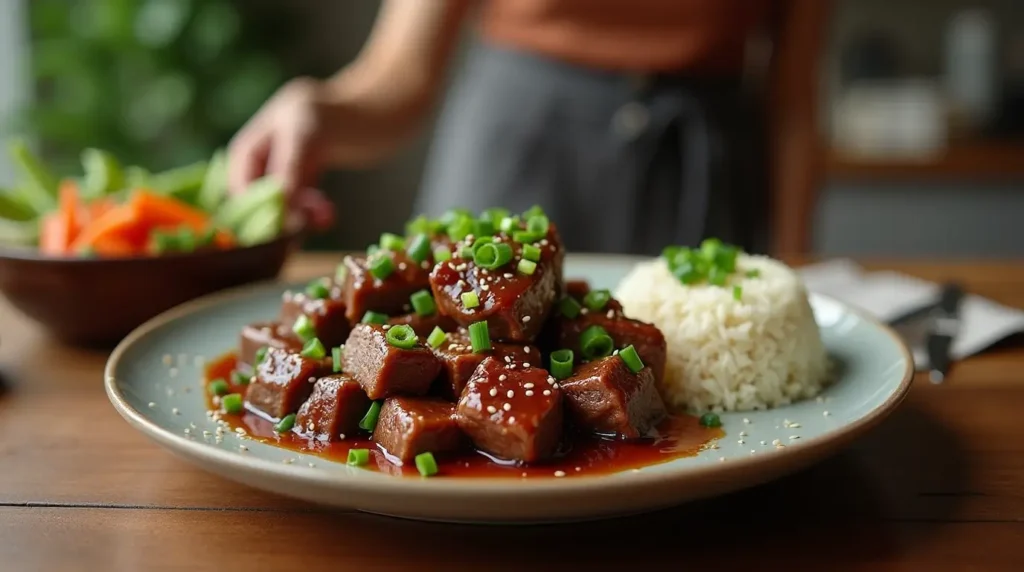Introduction to Korean Bulgogi with Ground Beef
Have you ever wanted to bring the amazing flavors of Korean cuisine right to your dinner table? Bulgogi recipe ground beef is the perfect place to start! This beloved Korean dish traditionally features thinly sliced beef marinated in a sweet and savory sauce, but our ground beef version makes it even more accessible for home cooks.
Bulgogi (which means “fire meat” in Korean) has been enjoyed in Korea for centuries, dating back to the Goguryeo era (37 BCE–668 CE). The dish was originally prepared for royalty, but today it’s a popular everyday meal throughout Korea and around the world. Using ground beef instead of the traditional sliced ribeye or sirloin makes this bulgogi recipe faster, more affordable, and just as delicious!
What makes this bulgogi recipe ground beef version so fantastic is how simple it is to prepare while still capturing all those authentic flavors. In under 30 minutes, you can create a meal that tastes like it came straight from a Korean restaurant. The ground beef soaks up the marinade beautifully, creating tender, juicy meat packed with sweet, savory, and umami flavors that will have everyone asking for seconds.
What Makes Bulgogi Special
The Perfect Flavor Balance
What sets bulgogi recipe ground beef apart from other dishes is its incredible flavor profile. The marinade creates a perfect harmony of:
- Sweet – usually from sugar, honey, or fruit (like Asian pears)
- Savory – from soy sauce and beef
- Umami – from garlic, onions, and sometimes mushrooms
- Nutty – from sesame oil and seeds
- Fresh – from green onions and sometimes ginger
This balance of flavors creates a dish that’s deeply satisfying without being overwhelming. The marinade caramelizes slightly when cooked, adding another dimension of flavor that makes bulgogi recipe ground beef absolutely irresistible.
Traditional vs. Modern Adaptations
Traditional bulgogi uses thinly sliced beef, typically ribeye or sirloin, that’s been frozen slightly to make it easier to slice paper-thin. The meat is then marinated and grilled over an open flame.
Modern adaptations like our ground beef version maintain the authentic flavors while making a few practical changes:
- Using ground beef instead of sliced meat
- Pan-frying instead of grilling
- Streamlining the ingredient list for accessibility
- Adding vegetables directly to the meat mixture
The Rising Popularity of Ground Beef Bulgogi
Bulgogi recipe ground beef has been gaining popularity for several compelling reasons:
- Affordability: Ground beef is typically less expensive than premium cuts.
- Convenience: No need for special slicing techniques or equipment.
- Versatility: The cooked meat works well in bowls, wraps, salads, and more.
- Kid-friendly: The smaller pieces and milder preparation make it appealing to children.
- Quick cooking: Ready in minutes instead of requiring long marination times.
This adaptation makes Korean cooking approachable for anyone, regardless of cooking experience or access to specialty ingredients.

Ingredients for Ground Beef Bulgogi
Getting the right ingredients is key for an authentic bulgogi recipe ground beef dish. Here’s everything you’ll need:
Main Ingredients
| Ingredient | Amount |
|---|---|
| Ground beef (80/20 lean-to-fat ratio) | 1 pound |
| Yellow onion, finely diced | 1 medium |
| Green onions, chopped | 3-4 stalks |
| Garlic, minced | 3-4 cloves |
| Ginger, grated (optional) | 1 tablespoon |
| Sesame seeds | 1 tablespoon |
Marinade Ingredients
| Ingredient | Amount |
|---|---|
| Soy sauce | ¼ cup |
| Brown sugar | 2 tablespoons |
| Asian pear, grated (or apple) | ¼ cup |
| Sesame oil | 1 tablespoon |
| Black pepper | ¼ teaspoon |
| Gochugaru (Korean chili flakes, optional) | 1 teaspoon |
Substitution Options for Hard-to-Find Ingredients
Don’t worry if you can’t find every traditional ingredient. Here are some easy substitutions:
- Asian pear: Regular pear, apple, or even 1 tablespoon of apple juice works
- Gochugaru: Regular red pepper flakes (use half the amount) or paprika for color without heat
- Sesame oil: While important for authentic flavor, you can use olive oil in a pinch
- Low-sodium options: Use reduced-sodium soy sauce if watching salt intake
Choosing the Right Ground Beef
For the best bulgogi recipe ground beef, the meat selection matters:
- Fat content: Choose 80/20 ground beef (80% lean, 20% fat) for the juiciest results
- Freshness: Fresh rather than frozen ground beef will have better texture
- Quality: If available, choose grass-fed or organic beef for better flavor
- Alternatives: Ground turkey or chicken can work, though the flavor profile will change
Equipment Needed
One of the best things about this bulgogi recipe ground beef version is that it requires minimal equipment. Here’s what you’ll need:
Basic Kitchen Tools Required
- Large mixing bowl (for marinating the meat)
- Measuring cups and spoons
- Sharp knife and cutting board
- Large skillet or frying pan (preferably non-stick or cast iron)
- Wooden spoon or spatula for stirring
- Small bowl (for mixing the marinade ingredients)
Optional Specialized Equipment
While not necessary, these items can enhance your bulgogi recipe ground beef preparation:
- Microplane or fine grater (for ginger and Asian pear)
- Garlic press
- Food processor (to quickly chop vegetables)
- Korean stone bowl (dolsot) for serving
Time-Saving Alternatives
Short on time? Try these helpful shortcuts:
- Use pre-minced garlic and ginger from the grocery store
- Buy pre-chopped onions from the produce section
- Invest in a garlic crusher that doesn’t require peeling
- Use a food processor to chop all vegetables at once

Step-by-Step Cooking Instructions
Follow these simple steps to make perfect bulgogi recipe ground beef every time:
Detailed Marinating Process
- In a small bowl, mix all marinade ingredients: soy sauce, brown sugar, grated Asian pear, sesame oil, black pepper, and gochugaru (if using).
- In a large bowl, combine the ground beef with the diced yellow onion, half of the green onions, minced garlic, and grated ginger.
- Pour the marinade over the meat mixture and mix thoroughly with your hands or a spoon until everything is well combined.
- Let the mixture sit for at least 15 minutes at room temperature. For deeper flavor, you can marinate it in the refrigerator for up to 4 hours.
Cooking Techniques for Perfect Texture
- Heat a large skillet over medium-high heat.
- Add the marinated ground beef mixture to the hot pan (no additional oil needed).
- Break up the meat with a wooden spoon as it cooks, maintaining some small chunks for texture.
- Cook for 7-10 minutes, stirring occasionally, until the meat is browned and the onions are translucent.
- If needed, drain excess fat from the pan (though a little fat adds flavor).
- Add half of the sesame seeds during the last minute of cooking.
Visual Cues for Doneness
Your bulgogi recipe ground beef is done when:
- The meat has changed from pink to brown throughout
- Most of the liquid has been absorbed or evaporated
- The onions are soft and translucent
- You can see a slight caramelization on some pieces of meat
- The mixture has a glossy appearance from the sauce
Garnish with the remaining green onions and sesame seeds before serving.
Serving Suggestions
Your bulgogi recipe ground beef is versatile and can be served in many delicious ways!
Traditional Korean Accompaniments
Serve your bulgogi with these authentic sides:
- Steamed white rice – The perfect base for soaking up the flavorful sauce
- Lettuce leaves – For making ssam (wraps)
- Kimchi – Traditional fermented cabbage for a tangy contrast
- Banchan – Small side dishes like pickled vegetables or spinach salad
- Gochujang sauce – For those who want to add extra heat
Modern Fusion Serving Ideas
Try these contemporary ways to enjoy your ground beef bulgogi:
- Bulgogi bowls – Serve over rice with sliced cucumbers, carrots, and a fried egg
- Bulgogi tacos – Spoon into corn tortillas with slaw and sriracha mayo
- Bulgogi sliders – On small buns with pickled vegetables
- Bulgogi nachos – Over tortilla chips with cheese, sour cream, and green onions
- Bulgogi loaded fries – As a topping for french fries with cheese and jalapeños
Family-Style Presentation Tips
Make dinner special with these presentation ideas:
- Serve the bulgogi recipe ground beef in a large central dish for everyone to share
- Create a DIY bulgogi bar with various toppings and wrapping options
- Use Korean stone bowls (dolsot) for a traditional presentation that keeps food hot
- Arrange colorful vegetable sides around the bulgogi for an appealing color contrast
- Sprinkle with extra sesame seeds and green onions just before bringing to the table
Health Benefits and Nutritional Information
Your bulgogi recipe ground beef isn’t just delicious—it can be part of a balanced diet too!
Protein Content and Other Nutritional Highlights
A typical serving of ground beef bulgogi provides:
- High-quality protein – About 25g per serving for muscle building and repair
- Iron – Essential for healthy blood and energy levels
- B vitamins – Important for metabolism and energy production
- Zinc – Supports immune function and wound healing
- Selenium – An antioxidant that protects cells from damage
Ways to Make the Recipe Healthier
Try these simple adjustments to boost nutrition:
- Use 90/10 lean ground beef to reduce fat content
- Add finely chopped vegetables like carrots, zucchini, or bell peppers to the meat mixture
- Reduce sugar in the marinade by using grated apple instead of brown sugar
- Add mushrooms to increase fiber and create a more filling meal with fewer calories
- Serve with brown rice instead of white rice for more fiber and nutrients
Dietary Adaptations
This bulgogi recipe ground beef can be adapted for various dietary needs:
For gluten-free diets:
- Use tamari or coconut aminos instead of regular soy sauce
For low-carb or keto diets:
- Substitute sugar with a keto-friendly sweetener
- Serve over cauliflower rice instead of regular rice
- Increase the serving of lettuce leaves for wrapping
For dairy-free needs:
- This recipe is naturally dairy-free!
Common Mistakes to Avoid
Make the perfect bulgogi recipe ground beef by avoiding these common errors:
Marinating Pitfalls
- Not mixing thoroughly – Make sure the marinade coats all the meat evenly
- Rushing the process – Even ground beef benefits from marination time
- Too much liquid – The marinade should coat the meat, not drown it
- Unbalanced flavors – Too much sugar or soy sauce can overpower the dish
Cooking Temperature Errors
- Heat too high – Can burn the sugars in the marinade before meat cooks through
- Heat too low – Won’t develop caramelization and can make meat soggy
- Crowding the pan – Cook in batches if needed to allow proper browning
- Constant stirring – Allow some contact with the hot pan to develop flavor
Seasoning Balance Tips
- Start with less seasoning – You can always add more, but you can’t take it away
- Taste before serving – Adjust salt, sweet, or heat levels as needed
- Remember that flavors intensify as the dish sits
- Balance is key – Neither soy sauce nor sugar should dominate
Variations of Ground Beef Bulgogi
Once you’ve mastered the basic bulgogi recipe ground beef, try these delicious variations!
Spicy Version
Turn up the heat with these additions:
- Double the amount of gochugaru (Korean chili flakes)
- Add 1-2 tablespoons of gochujang (Korean chili paste)
- Mix in thinly sliced fresh jalapeños or serranos
- Include a drizzle of chili oil before serving
- Serve with additional gochujang sauce on the side
Kid-Friendly Adaptation
Make it appealing for younger palates:
- Reduce or eliminate the black pepper and any spicy ingredients
- Increase the sweet elements slightly (more pear or a touch more sugar)
- Chop the vegetables extra fine so they’re less noticeable
- Serve with familiar sides like steamed rice or even french fries
- Create fun lettuce “tacos” that kids can assemble themselves
Meal Prep Suggestions
This bulgogi recipe ground beef is perfect for meal planning:
- Double batch cooking – Make extra and store in meal-sized portions
- Bulgogi rice bowls – Portion into containers with rice and vegetables
- Freezer-friendly packages – Freeze raw marinated meat for quick future meals
- Multi-purpose protein – Use in different dishes throughout the week
- Lettuce wrap kit – Store components separately for easy assembly
Storage and Reheating Tips
Make the most of your leftover bulgogi recipe ground beef with these storage tips:
Proper Refrigeration Guidelines
- Store cooked bulgogi in airtight containers in the refrigerator
- Consume within 3-4 days for best quality and safety
- Keep separate from raw foods in your refrigerator
- Cool completely before refrigerating (within 2 hours of cooking)
- Store rice separately from meat for best texture when reheating
Freezing Instructions
Bulgogi recipe ground beef freezes beautifully:
- Cool completely before freezing
- Portion into meal-sized containers or freezer bags
- Remove as much air as possible to prevent freezer burn
- Label with the date and contents
- Freeze for up to 3 months
- You can also freeze the raw marinated meat for up to 1 month
Best Reheating Methods
For the tastiest reheated bulgogi recipe ground beef:
Microwave method:
- Place in a microwave-safe container
- Add a tablespoon of water to maintain moisture
- Cover loosely
- Heat on medium power for 1-2 minutes, stirring halfway through
Stovetop method (preferred):
- Heat a skillet over medium heat
- Add a teaspoon of oil or water
- Add the bulgogi and stir frequently
- Heat until warmed through (about 3-4 minutes)
- Add a splash of water if it seems dry

Frequently Asked Questions About Bulgogi Recipe Ground Beef
Can I make bulgogi recipe ground beef without Asian pear?
Yes! While Asian pear adds natural sweetness and tenderizing enzymes to bulgogi recipe ground beef, you can substitute with regular pear, apple, kiwi, or even pineapple. In a pinch, you can use 1-2 tablespoons of apple juice or just add a bit more sugar to the marinade.
How spicy is traditional bulgogi recipe ground beef?
Traditional bulgogi is actually not spicy at all! It’s characterized by a sweet and savory flavor profile. The spiciness is optional and varies by personal preference. If you enjoy heat, add gochugaru (Korean chili flakes) or gochujang (Korean chili paste) to your marinade.
Can I use other types of ground meat for bulgogi?
Absolutely! While beef is traditional, this bulgogi recipe works wonderfully with ground turkey, chicken, or pork. You can even use plant-based ground meat substitutes. Just note that leaner meats like turkey might need a bit more oil added during cooking to prevent dryness.
How long should I marinate ground beef bulgogi?
Unlike whole muscle cuts that benefit from longer marination, ground beef can be cooked after just 15-30 minutes of marinating. However, you can marinate it for up to 4 hours in the refrigerator for deeper flavor development. Avoid marinating ground meat longer than that, as the texture can become mushy.
What’s the difference between bulgogi and other Korean beef dishes?
Bulgogi recipe ground beef features a sweet-savory marinade and is typically not spicy. Galbi is made with beef short ribs in a similar marinade. Japchae includes sweet potato noodles with beef and vegetables. Bibimbap includes beef on rice with vegetables and gochujang. Bulgogi is distinguished by its slightly sweet flavor profile and traditionally thinly-sliced beef preparation.
Conclusion
This bulgogi recipe ground beef version brings the incredible flavors of Korean cuisine right to your kitchen in a way that’s accessible, affordable, and absolutely delicious. By using ground beef instead of traditional sliced meat, you’ve got a versatile dish that comes together in minutes instead of hours—without sacrificing any of that authentic sweet-savory flavor that makes bulgogi so popular worldwide.
What makes this recipe truly stand out is its versatility. Whether you’re serving it traditionally over rice, packing it into lettuce wraps, or getting creative with fusion dishes like bulgogi tacos or loaded fries, this recipe delivers restaurant-quality taste with home cook simplicity.
Now it’s your turn to try this bulgogi recipe ground beef in your own kitchen! Don’t be afraid to adjust the seasonings to your family’s preferences or experiment with some of the variations we’ve suggested. And once you’ve made it, we’d love to hear how it turned out! Drop a comment below sharing your experience, any modifications you made, or your favorite way to serve this Korean-inspired dish.
Ready to bring more global flavors to your dinner table? Bookmark this page and check back for more internationally-inspired recipes made simple!

